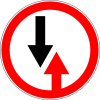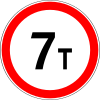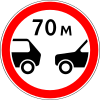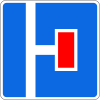Road signs in the Soviet Union

Road signs in the Soviet Union were regulated in the ГОСТ 10807-78 standard which was introduced on 1 January 1980.[1][2] This standard also specified the typeface used on road signs. After the dissolution of the Soviet Union in 1991, this standard continued to apply in all countries that were formerly Soviet republics until some of them adopted their own national standards for road signs. The shapes and colors of road signs in the Soviet Union, and now in all post-Soviet states, fully comply with the 1968 Vienna Convention on Road Signs and Signals, to which the Soviet Union was originally a signatory. On 8 November 1968, the Soviet Union signed the Vienna Convention on Road Signs and Signals, and on 7 June 1974 ratified it with some declarations and reservations made upon ratification.[3][4]
Road signs in the Soviet Union were divided into 7 categories:
- Warning signs (Предупреждающие знаки)
- Priority signs (Знаки приоритета)
- Prohibitory signs (Запрещающие знаки)
- Mandatory signs (Предписывающие знаки)
- Information signs (Информационно-указательные знаки)
- Service signs (Знаки сервиса)
- Additional signs (Знаки дополнительной информации (таблички))
Below are images of road signs used in the Soviet Union before its dissolution in 1991. The galleries shown below do not show road signs that were included in the ГОСТ 10807-78 standard after 1991. The vast majority of road signs shown below are still used in post-Soviet states such as Russia, Armenia, Azerbaijan, Belarus, Georgia, Kazakhstan, Kyrgyzstan, Lithuania, Tajikistan, Turkmenistan, Ukraine, and Uzbekistan but with some modifications in design.
Warning signs
[edit]- 1. Warning signs
-
1.1 Railway crossing with a barrier
-
1.2 Railway crossing without a barrier
-
1.3.1 Single-track railway
-
1.3.2 Multi-track railway
-
1.4.1 Approaching a railway crossing
-
1.4.2 Approaching a railway crossing
-
1.4.3 Approaching a railway crossing
-
1.4.4 Approaching a railway crossing
-
1.4.5 Approaching a railway crossing
-
1.4.6 Approaching a railway crossing
-
1.5 Trams
-
1.6 Intersection of equivalent roads
-
1.7 Roundabout
-
1.8 Traffic signals
-
1.9 Opening bridge
-
1.10 Departure to the embankment
-
1.11.1 Dangerous curve to the right
-
1.11.2 Dangerous curve to the left
-
1.12.1 Dangerous curves
-
1.12.2 Dangerous curves
-
1.13 Steep descent
-
1.14 Steep climb
-
1.15 Slippery road
-
1.16 Uneven road
-
1.17 Gravel surface
-
1.18.1 Narrowing of the road on both sides
-
1.18.2 Narrowing of the road on the right
-
1.18.3 Narrowing of the road on the left
-
1.19.1 Two-way traffic
-
1.20 Pedestrian crossing ahead
-
1.21 Children
-
1.22 Intersection with a bike path or bike and pedestrian path
-
1.23 Roadworks
-
1.24 Cattle
-
1.25 Wild animals
-
1.26 Falling rocks surface
-
1.27 Side wind
-
1.28 Low-flying aircraft
-
1.29 The tunnel
-
1.30 Other hazards
-
1.31.1 Hazard chevron
-
1.31.2 Hazard chevron
-
1.31.3 Hazard chevron
Priority signs
[edit]- 2. Priority signs
-
2.1 Priority road
-
2.2 End of priority road
-
2.3.1 Intersection with a secondary road
-
2.3.2 Secondary road junction
-
2.3.3 Secondary road junction
-
2.4 Give way
-
2.5 Stop sign
-
2.6 Give way to oncoming traffic
-
2.7 Priority over oncoming traffic
Prohibitory signs
[edit]- 3. Prohibitory signs
-
3.1 Entry is prohibited
-
3.2 Traffic is prohibited
-
3.3 The movement of motor vehicles is prohibited
-
3.4 Lorries exceeding indicated weight prohibited
-
3.5 The movement of motorcycles is prohibited
-
3.6 The movement of tractors is prohibited
-
3.7 Driving with a trailer is prohibited
-
3.8 The movement of horse-drawn carts is prohibited
-
3.9 Cycling is prohibited
-
3.10 Pedestrian traffic is prohibited
-
3.11 Vehicle weight limit
-
3.12 Limitation of the mass per axle of the vehicle
-
3.13 Height limit
-
3.14 Width limit
-
3.15 Length limit
-
3.16 Limitation of the minimum distance
-
3.17.1 Customs
-
3.17.2 Danger
-
3.18.1 Turning to the right is prohibited
-
3.18.2 Turning to the left is prohibited
-
3.19 U-turn is prohibited
-
3.20 Overtaking is prohibited
-
3.21 End of overtaking prohibition zone
-
3.22 Overtaking by trucks is prohibited
-
3.23 End of the zone prohibiting overtaking RU trucks
-
3.24 Maximum speed limit
-
3.25 End of the maximum speed limit zone
-
3.26 Beeping is prohibited
-
3.27 Stopping is prohibited
-
3.28 Parking is prohibited
-
3.29 Parking is prohibited on odd days of the month
-
3.30 Parking is prohibited on even days of the month
-
3.31 End of all restrictions zone
-
3.32 The movement of vehicles with dangerous goods is prohibited
-
3.33 No vehicles with explosive and flammable loads
Mandatory signs
[edit]- 4. Mandatory signs
-
4.1.1 Driving straight
-
4.1.2 Turn right
-
4.1.3 Turn left
-
4.1.4 Proceed straight or turn right
-
4.1.5 Proceed straight or turn left
-
4.1.6 Turn right or left
-
4.2.1 Keep right
-
4.2.2 Keep left
-
4.2.3 Keep right or left
-
4.3 Direction of roundabout traffic
-
4.4 Passenger car traffic
-
4.5 Bicycle path
-
4.6 Footpath
-
4.7 Minimum speed limit
-
4.8 End of the minimum speed limit zone
Information signs
[edit]- 5. Information signs
-
5.1 Motorway
-
5.2 End of the motorway
-
5.3 Road for cars
-
5.4 End of the road for cars
-
5.5 One-way road
-
5.6 End of one-way road
-
5.7.1 Exit to a one-way road
-
5.7.2 Exit to a one-way road
-
5.8.1 Lane directions
-
5.8.2 Lane directions
-
5.8.2 Lane directions
-
5.8.2 Lane directions
-
5.8.2 Lane directions
-
5.8.2 Lane directions
-
5.8.2 Lane directions
-
5.8.2 Lane directions
-
5.8.3 The beginning of the lane
-
5.8.3 The beginning of the lane
-
5.8.4 The beginning of the lane
-
5.8.5 End of the lane
-
5.8.6 End of the lane
-
5.8.7 Lane direction
-
5.8.7 Lane direction
-
5.8.8 Lane direction
-
5.8.8 Lane direction
-
5.9 Bus lane
-
5.10.1 A road with a line for fixed-route vehicles
-
5.10.2 End of the road with a lane for fixed-route vehicles
-
5.10.3 Exit to the road with a lane for fixed-route vehicles
-
5.11.1 U-turn
-
5.11.2 U-turn
-
5.12 Bus and/or trolleybus stop location
-
5.13 Tram stop location
-
5.14 Taxi stop
-
5.15 Parking
-
5.16.1 Pedestrian crossing
-
5.16.2 Pedestrian crossing
-
5.17.1 Subway (underpass)
-
5.17.2 Subway (underpass)
-
5.17.3 Footbridge
-
5.17.4 Footbridge
-
5.18 Recommended speed
-
5.19.1 Dead end
-
5.19.2 Dead end
-
5.19.3 Dead end
-
5.20.1 A preliminary sign of directions
-
5.20.1 A preliminary sign of directions
-
5.20.2 A preliminary sign of direction
-
5.20.3 Traffic scheme
-
5.21.1 Pointing direction
-
5.21.1 Pointing direction
-
5.21.2 Pointing directions
-
5.22.1 Entrance to built-up area
-
5.23.1 End of built-up area
-
5.24 Entrance to locality
-
5.25 End of locality
-
5.26 Object name (river name)
-
5.26 Object name (street name)
-
5.27 Distance indicator
-
5.28 Kilometer sign
-
5.29.1 Route number
-
5.29.1 Route number
-
5.29.2 Route number and direction
-
5.29.2 Route number and direction
-
5.29.2 Route number and direction
-
5.30.1 Direction of movement for trucks
-
5.30.2 Direction of movement for trucks
-
5.30.3 Direction of movement for trucks
-
5.31 Detour scheme
-
5.32.1 Detour direction
-
5.32.2 Detour direction
-
5.32.3 Detour direction
-
5.33 Stop line
Service signs
[edit]- 6. Service signs
-
6.1 Point of medical care
-
6.2 Hospital
-
6.3 Gas station
-
6.4 Vehicle maintenance
-
6.5 Car washing
-
6.6 Phone
-
6.7 Food point
-
6.8 Drinking water
-
6.9 Hotel or motel
-
6.10 Camping
-
6.11 Place of rest
-
6.12 State Traffic Inspectorate (ГАИ)
Additional signs
[edit]- 7. Additional plates
-
7.1.1 Distance to the object
-
7.1.2 Distance to the object
-
7.1.3 Distance to the object
-
7.1.4 Distance to the object
-
7.2.1 Coverage area
-
7.2.2 Coverage area
-
7.2.3 Coverage area
-
7.2.4 Coverage area
-
7.2.5 Coverage area
-
7.2.6 Coverage area
-
7.3.1 Directions of action
-
7.3.2 Directions of action
-
7.3.3 Directions of action
-
7.4.1 Type of vehicle
-
7.4.2 Type of vehicle
-
7.4.3 Type of vehicle
-
7.4.4 Type of vehicle
-
7.4.5 Type of vehicle
-
7.4.6 Type of vehicle
-
7.4.7 Type of vehicle
-
7.4.8 Type of vehicle
-
7.5.1 Saturdays, Sundays and holidays
-
7.5.2 Working days
-
7.5.3 Days of the week
-
7.5.4 Validity period
-
7.5.5 Validity period
-
7.5.6 Validity period
-
7.5.7 Validity period
-
7.6.1 Method of parking the vehicle
-
7.6.2 Method of parking the vehicle
-
7.6.3 Method of parking the vehicle
-
7.6.4 Method of parking the vehicle (park in backwards)
-
7.6.5 Method of parking the vehicle (front wheels of car facing curb)
-
7.7 No idling engine while parked here (Number of dangerous turns must be incorrect)
-
7.8 Paid services
-
7.9 Limitation of parking duration
-
7.10 Place for car inspection
-
7.11 Limitation of the permitted maximum mass
-
7.12 Dangerous roadside
-
7.13 Direction of the main road
-
7.14 Traffic lane
-
7.15 Blind pedestrians
Post-Soviet states
[edit]After 1991, the ГОСТ 10807-78 standard was replaced by the new ones, i.e., national standards for road signs in each of the post-Soviet states:
- In Russia, it was replaced by the ГОСТ Р 52290-2004 standard on January 1, 2006.[5][6] The same standard applies to road signs used in Kyrgyzstan since October 2019[7][8] and Armenia[9][10] (with inscriptions in Armenian and English);
- In Ukraine, it was replaced by the ДСТУ 2586-94 standard in 1994,[11][12] later ДСТУ 4100-2002 on January 1, 2003,[13] ДСТУ 4100-2014 on July 1, 2015,[14] ДСТУ 4100:2021 on November 1, 2021;[15][16]
- In Belarus, it was replaced by the СТБ 1140-99 on October 1, 2001,[17] later СТБ 1140-2013 on July 1, 2014;[18]
- In Kazakhstan, it was replaced by the СТ РК 1125-2002 standard on January 1, 2004,[19] later СТ РК 1125-2021 on July 1, 2022;[20]
- In Uzbekistan, it was replaced by the O'zDST 3283:2017 standard on December 15, 2017.[21]
The ГОСТ 10807-78 Soviet standard is still valid in Azerbaijan[22][23] and Turkmenistan,[24] but with additions.
References
[edit]- ^ "Межгосударственный стандарт ГОСТ 10807-78 "Знаки дорожные. Общие технические условия" (утв. постановлением Госстандарта СССР 30.08.1978 N 2401) (с изменениями и дополнениями) (не действует) | ГАРАНТ". base.garant.ru (in Russian). Retrieved 20 March 2023.
- ^ "Скачать ГОСТ 10807-78 Знаки дорожные. Общие технические условия". meganorm.ru (in Russian). Retrieved 25 March 2023.
- ^ "United Nations Treaty Collection". treaties.un.org. Retrieved 24 November 2023.
- ^ "КОНВЕНЦИЯ О ДОРОЖНОМ ДВИЖЕНИИ от 08.11.1968 Вена | ATI.SU". ati.su (in Russian). Retrieved 24 November 2023.
- ^ "Дорожные знаки по ГОСТу Р 52290-2004 (от 14.12.2005)". www.sevdorstroy.ru (in Russian). 14 December 2005. Retrieved 14 November 2023.
- ^ "ГОСТ Р 52289-2004 Технические средства организации дорожного движения. Правила применения дорожных знаков, разметки, светофоров, дорожных ограждений и направляющих устройств" (PDF). joldo.kg (in Russian).
- ^ "Постановление Правительства КР от 7 октября 2019 года № 522 "О внесении изменений в постановление Правительства Кыргызской Республики "Об утверждении Правил дорожного движения и Основных положений по допуску транспортных средств к эксплуатации и обязанностей должностных лиц по обеспечению безопасности дорожного движения" от 4 августа 1999 года № 421"". cbd.minjust.gov.kg (in Russian). Retrieved 14 November 2023.
- ^ "Технические средства организации дорожного движения. Знаки дорожные. Общие технические требования". standarts.nism.gov.kg (in Russian). Retrieved 14 November 2023.
- ^ "ՀԱՅԱՍՏԱՆԻ ՀԱՆՐԱՊԵՏՈՒԹՅԱՆ ԿԱՌԱՎԱՐՈՒԹՅՈՒՆ". www.arlis.am (in Armenian). Retrieved 26 August 2023.
- ^ "ԳՕՍՏ Ռ 52290-2004". armstandard.am (in Armenian).
- ^ "ДСТУ 2586-94". Словари и энциклопедии на Академике (in Russian and Ukrainian). Retrieved 14 November 2023.
- ^ "ГОСТ 10807-78". Словари и энциклопедии на Академике (in Russian and Ukrainian). Retrieved 14 November 2023.
- ^ "ДСТУ 4100-2002" (PDF). pdd.com.ua (in Ukrainian).
- ^ "ДСТУ 4100:2014 Безпека дорожнього руху. Знаки дорожні. Загальні технічні умови. Правила застосування". online.budstandart.com (in Ukrainian). Retrieved 14 November 2023.
- ^ "New Standard of Road Signs". DerzhdorNDI SE. Retrieved 22 October 2023.
- ^ "ДСТУ 4100:2021 Безпека дорожнього руху" (PDF). zakon.isu.net.ua (in Ukrainian). 14 September 2022.
- ^ "СТБ 1140-99. Знаки дорожные. Общие технические условия". rovar.info (in Russian). 30 January 2018. Retrieved 14 November 2023.
- ^ "СТБ 1140-2013: Технические средства организации дорожного движения. Знаки дорожные. Общие технические условия". standartgost.ru (in Russian). Retrieved 14 November 2023.
- ^ "Скачать СТ РК 1125-2002 Знаки дорожные. Общие технические условия". files.stroyinf.ru (in Russian). Retrieved 14 November 2023.
- ^ "СТ РК 1125-2021 Технические средства организации дорожного движения. Знаки дорожные. Общие технические требования". vostoktranssignal.kz (in Russian and Kazakh).
- ^ "3283:2017-сон 15.12.2017. Знаки дорожные". lex.uz (in Russian). 15 December 2017. Retrieved 14 November 2023.
- ^ Avtosfer.az (11 May 2020). "Bu işi yol nişanlarından başladıq… - YENİ RUBRİKADAN ÖYRƏNƏK". Avtosfer.az (in Azerbaijani). Retrieved 16 September 2023.
- ^ Aliyev, Anar (16 March 2019). "Daha çox insanın həyatını qoruya biləcək yeni qanun və qaydalar". İnsan yönümlü şəhərlər (in Azerbaijani). Retrieved 16 September 2023.
- ^ Atamyradow, H. (2019). Ýol hereketi we howpsuzlygy (in Turkmen). Ashgabat: Türkmen döwlet neşirýat gullugy.
See also
[edit]- Comparison of European road signs
- Traffic signs in post-Soviet states
- Road signs in Armenia
- Road signs in Azerbaijan
- Road signs in Belarus
- Road signs in Estonia
- Road signs in Georgia
- Road signs in Kazakhstan
- Road signs in Kyrgyzstan
- Road signs in Latvia
- Road signs in Lithuania
- Road signs in Russia
- Road signs in Tajikistan
- Road signs in Turkmenistan
- Road signs in Ukraine
- Road signs in Uzbekistan










































































































































































































